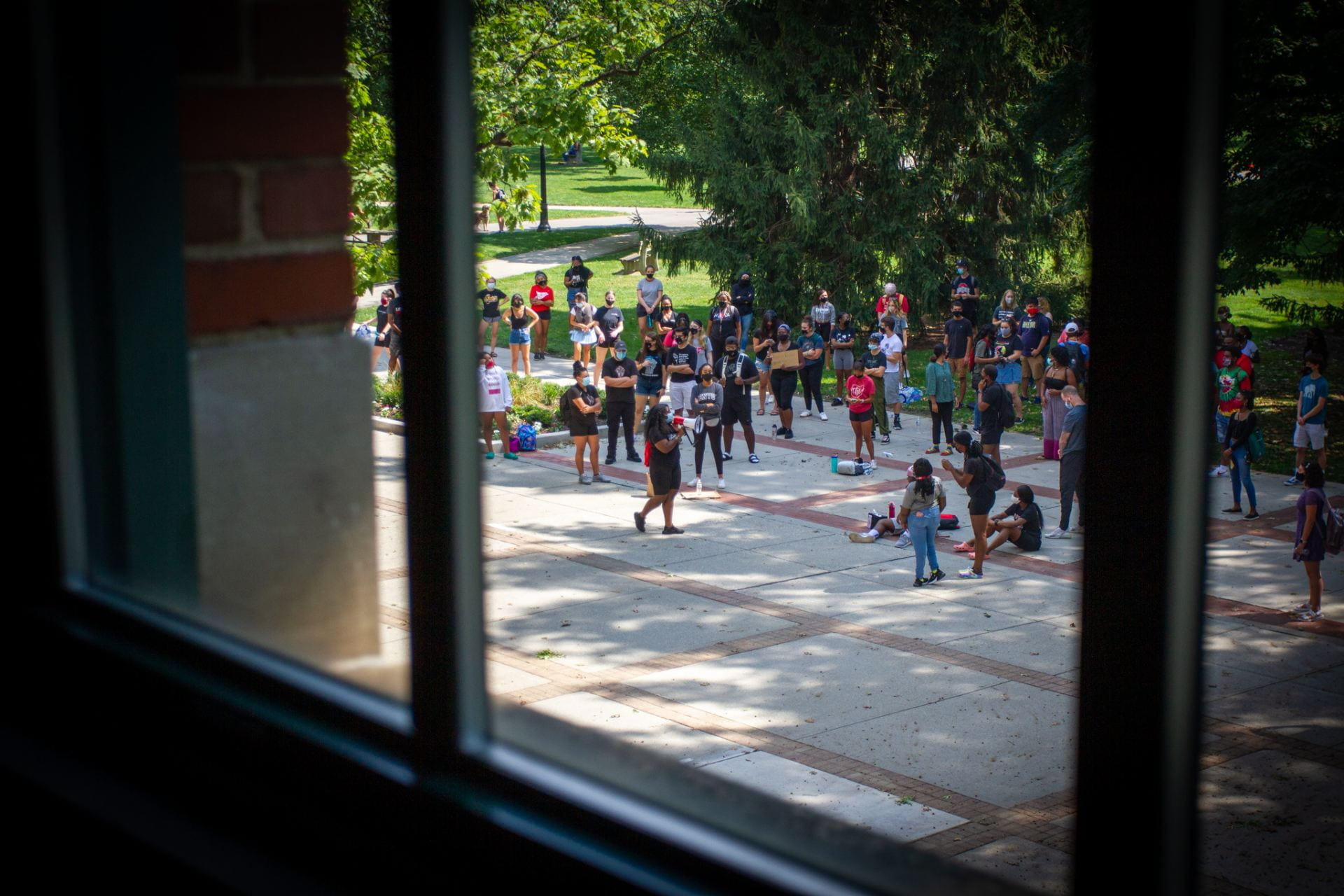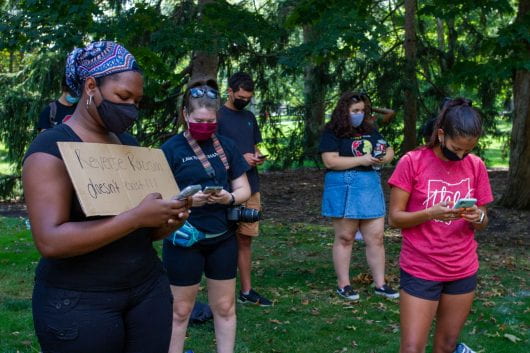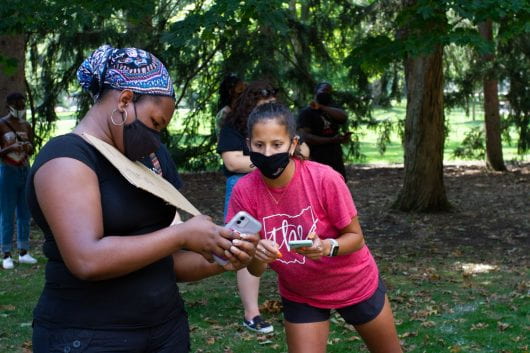
A student-led demonstration outside Bricker Hall, where the President’s office is located. Credit: Jack Long | Managing Editor for Digital Content
A series of emails has left Ohio State’s Black student body questioning the fairness of the university’s responses to racist crimes.
A public safety notice sent out by the university on Thursday detailed hate crimes, classified by the university that happened Sept. 2 involving two Black suspects, one male and one female, who were charged with felonious assault and assault. At the time this email was sent, the race of the victims of the crimes were not identified.
University Police Chief Kimberly Spears-McNatt said that the university was required to report the incidents as hate crimes and aggravated assaults as they met requirements under the Jeanne Clery Act, a federal law which requires institutions of higher learning to report certain crimes that occur on or near their campuses.
In a follow-up email sent out Friday, the Department of Public Safety confirmed that the victims of the crimes were white. In another follow-up email sent out on Saturday, the suspects’ names were released after it was announced that they were in custody.
The news sent social media into an outrage, with many people speaking about and against the three emails and their contents.
“OSU is mocking their entire Black student body right now. They’re blatantly making campus more uncomfortable and dangerous for us and POC,” Deja Geddings, a second-year in business, tweeted.
Another tweet read: “there’s two black hoodlums assaulting white Ohio state students just because they are white (WHICH IS A HATE CRIME) and this is the only response we get? I recommend y’all start carrying a knife too.” The account of the tweet’s author has since been deleted.
The emails and reactions prompted a demonstration Tuesday outside of Bricker Hall, where University President Kristina Johnson’s office is located. Fliers made for the event asked the question, “Why Does OSU Only Uphold the Safety of White Students?” At the event, Black students expressed their frustration with the emails and the implications they felt the emails made toward the Black student body.

Signs left outside of Bricker Hall following a demonstration organized by the Black OSU Community show the frustration Black students currently feel towards the university. The Department of Public Safety sent out three emails reporting assaults classified as hate crimes last week, and their contents upset the Black student Body. Credit: André White | Arts & Life Producer
Devon Stith, a third-year in exploration, said that the public safety notice’s definition of the assaults that took place Wednesday as a hate crime advocates for reverse racism, the idea that Black people can be racist towards white people.
“Even if, say, all Black people are afraid, scared, think white people are horrible people and are raising all their children to not speak to white people, avoid white people, everything like that, that’s not going to affect the white community’s success in life in this country. They’re not going to be hurt by our rhetoric,” Stith said. “But, on the flip side, we have been and will continue to be hurt as long as their rhetoric is destructive.”
Ernest Moore III, a fourth-year in biology, said the lack of description of the suspects outside of their races in the Thursday email endangered Black students on campus. He called the description in the public safety notice “negligent.”
“If you put out just like, ‘There’s a Black male’ or ‘There’s Black suspects out there,’ there’s Black people on campus. Like, how do you differentiate who’s who? There’s no description, there’s no height, there’s no any type of recognition, anything. And that’s why it’s dangerous; we’re the minority here,” Moore said.
Spears-McNatt said that the race of the victims was mistakenly omitted in the initial notice, with the correction sent out in the campus-wide email Friday.
“We apologize for this omission and any questions or concerns it may have caused,” Spears-McNatt said in the email.
Stith said that the release of the victim’s races was retroactive because the original email “already did the damage.” He said the victims being white was “the cherry on top of how messed up the situation is.”
Both students spoke on how they have never seen a public safety notice sent in this manner, highlighting the use of the suspects’ names when arrested and the classification of the assaults as a hate crime. Stith said it was “shocking” that this crime led to these statements from the Department of Public Safety.
The Department of Education’s 2016 Handbook for Campus Safety and Security Reporting defines a hate crime as a “criminal offense that manifests evidence that the victim was intentionally selected because of the perpetrator’s bias against the victim.” Race is one of eight categories of bias under this definition.
University spokesperson Dan Hedman said that because the suspects were of a different race than the victims, the racial slur used in Wednesday’s incident fell under the Clery Act’s definition of a hate crime, and the university was legally obligated to report it as such. The two suspects were not arrested under charges of a hate crime.
Hedman said that the university has released the names of victims “in past cases when the arrest was made within days of the initial notice,” but this has not happened since June 2018, when University Police arrested a man for the rape and kidnapping of a student five days after the crime occurred.
Leaders in the Department of Public Safety met with the students, faculty and staff who are members of the university’s newly formed Public Safety Advisory Committee Tuesday and discussed potential changes to the protocol regarding naming charged suspects, Spears-McNatt said.
During the demonstration, Roaya Higazi, a fourth-year in city and regional planning and Undergraduate Student Government President, criticized a portion of the Department of Public Safety’s Saturday email in which they thanked the Columbus Police Department for “assisting in the apprehension of the suspects.”
Higazi, along with the presidents of the Council of Graduate Students and the Inter-Professional Council, sent an open letter to former University President Michael V. Drake in June asking Ohio State to cease on-campus operations and review off-campus contracts with the Columbus Police Department. Higazi said that the letter had 21,000 signatures.
Moore said that the Department of Public Safety thanking the Columbus Police Department was “completely disrespectful.”
“In a time that we’re in right now where we did a petition, where we had so-many-thousand signatures of people who want us to cut ties with the Columbus Police Department for the things they did over the summer – tear gas, beating up protestors, all things like that …,” Moore said. “When things like that happen and you say, ‘Thank you CPD,’ it’s just like, that’s a slap in the face.”
Alexander Ushry, a third-year in finance, called into question the true meaning of the “Together as Buckeyes” slogan. He said the slogan only focuses on the COVID-19 pandemic.
“They just care about that and not everything,” Ushry said. “When they say ‘Together as Buckeyes,’ once again, it’s a slap in the face. Are we really together as Buckeyes?”
This story was updated at 10:09 p.m. with correct attribution to University Police Chief Kimberly Spears-McNatt.




